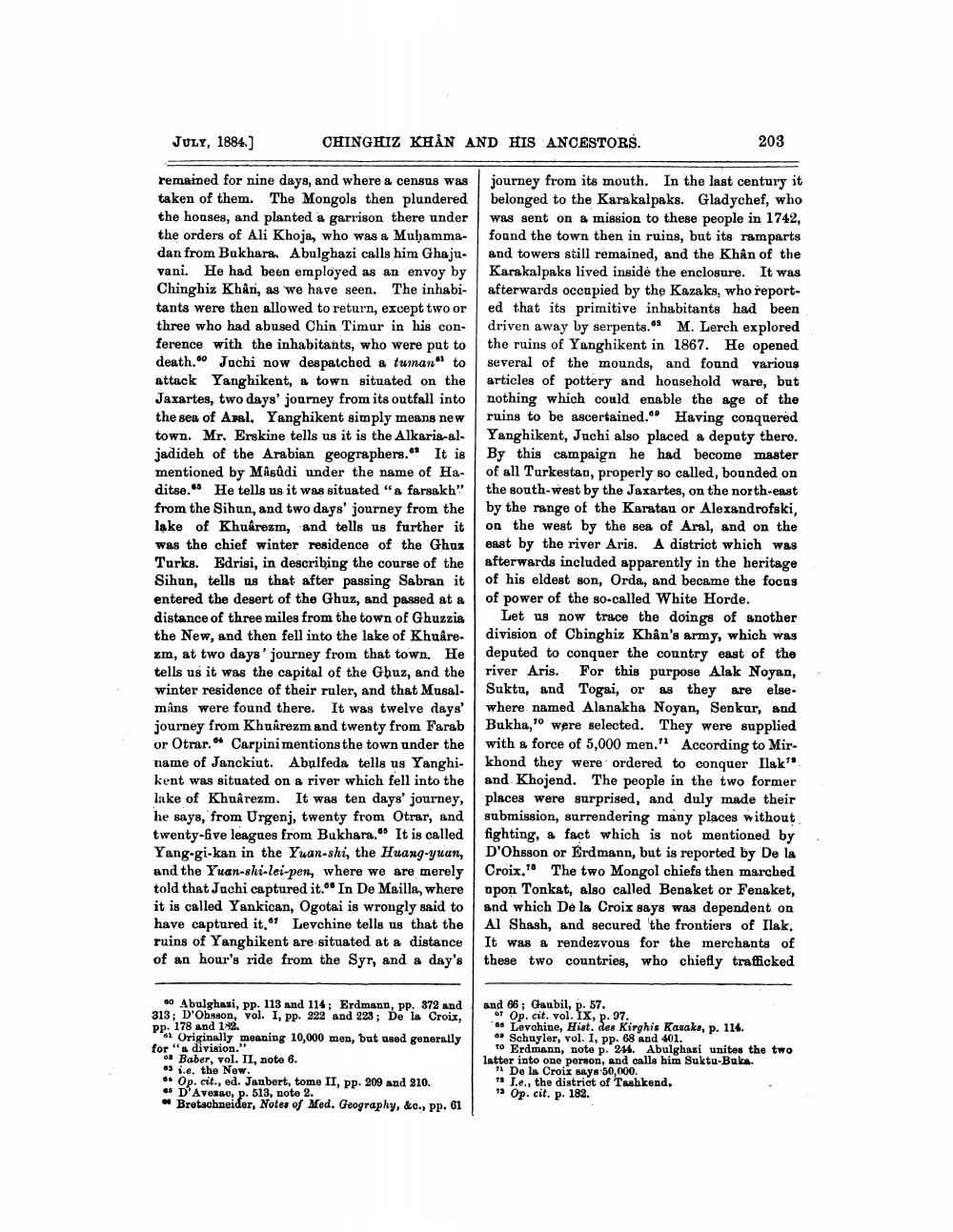________________
JULY, 1884.)
CHINGHIZ KHÅN AND HIS ANCESTORS.
203
remained for nine days, and where a census was taken of them. The Mongols then plundered the houses, and planted a garrison there under the orders of Ali Khoja, who was a Muhammadan from Bukhara. Abulghazi calls him Ghaju. vani. He had been employed as an envoy by Chinghiz Khân, as we have seen. The inhabitants were then allowed to return, except two or three who had abused Chin Timur in his conference with the inhabitants, who were put to death. Jochi now despatched a tuman" to attack Yanghikent, a town situated on the Jazartes, two days' journey from its outfall into the sea of Aval. Yanghikent simply means new town. Mr. Erskine tells us it is the Alkaria-al- jadideh of the Arabian geographers. It is mentioned by Masûdi under the name of Ha- ditse." He tells us it was situated "a farsakh" from the Sihun, and two days' journey from the lake of Khuárezm, and tells us further it was the chief winter residence of the Ghuz Turks. Edrisi, in describing the course of the Sihun, tells us that after passing Sabran it entered the desert of the Ghuz, and passed at a distance of three miles from the town of Ghuzzia the New, and then fell into the lake of Khuârezm, at two days' journey from that town. He tells us it was the capital of the Gbuz, and the
he capital of the Ghuz, and the winter residence of their ruler, and that Musal. mins were found there. It was twelve days' journey from Khuárezm and twenty from Farab or Otrar." Carpini mentions the town under the name of Janckiut. Abulfeda tells us Yanghikent was situated on a river which fell into the lake of Khuâ rezm. It was ten days' journey, he says, from Urgenj, twenty from Otrar, and twenty-five leagues from Bukhara. It is called Yang-gi-kan in the Yuan-shi, the Huang-yuan, and the Yuan-shi-lei-pen, where we are merely told that Jachi captured it. In De Mailla, where it is called Yankican, Ogotai is wrongly said to have captured it. Levchine tells us that the ruins of Yanghikent are situated at a distance of an hour's ride from the Syr, and a day's
journey from its mouth. In the last century it belonged to the Karakalpaks. Gladychef, who was sent on a mission to these people in 1742, found the town then in ruins, but its remparts and towers still remained, and the Khân of the Karakalpaks lived inside the enclosure. It was afterwards occupied by the Kazaks, who reported that its primitive inhabitants had been driven away by serpents. M. Lerch explored the ruins of Yanghikent in 1867. He opened several of the mounds, and found various articles of pottery and household ware, but nothing which could enable the age of the ruins to be ascertained. Having conquered Yanghikent, Juchi also placed a deputy thero. By this campaign he had become master of all Turkestan, properly so called, bounded on the south-west by the Jaxartes, on the north-east by the range of the Karatau or Alexandrofski, on the west by the sea of Aral, and on the east by the river Aris. A district which was afterwards included apparently in the heritage of his eldest son, Orda, and became the focus of power of the so-called White Horde.
Let us now trace the doings of another division of Chinghiz Khân's army, which was deputed to conquer the country east of the river Aris. For this purpose Alak Noyan, Suktu, and Togai, or as they are elsewhere named Alanakha Noyan, Senkur, and Bukha,' were selected. They were supplied with a force of 5,000 men." According to Mir. khond they were ordered to conquer llak" and Khojend. The people in the two former places were surprised, and duly made their submission, surrendering many places without fighting, a fact which is not mentioned by D'Ohsson or Erdmann, but is reported by De la Croix." The two Mongol chiefs then marched opon Tonkat, also called Bena ket or Fenaket, and which De la Croix says was dependent on Al Shash, and secured the frontiers of Ilak. It was a rendezvous for the merchants of these two countries, who chiefly trafficked
60 Abulghasi, pp. 113 and 114; Erdmann, pp. 372 and 313; D'Ohsson, vol. I, pp. 222 and 223; De la Croix, pp. 178 and 12
& Originally meaning 10,000 men, but used generally for "a division."
.: Baber, vol. II, note 6. es i.e. the New. ** Op. cit., ed. Jaubert, tome II, pp. 209 and 210. as D Avesso, p. 513, note 2.
Bretachneider, Notes of Med. Geography, &c., PP. 61
and 66; Gaubil, p. 57.
07 Op.cit. vol. IX, p. 97. 68 Levchine, Hist. des Kirghis Kazaks, p. 114. ** Schuyler, vol. I, pp. 68 and 401.
10 Erdmann, note p. 244. Abulghazi unites the two latter into one person, and calls him Suktu-Bake.
11 De la Croix says-50,000. * I.e., the district of Tashkend. 13 Op. cit. p. 182.




